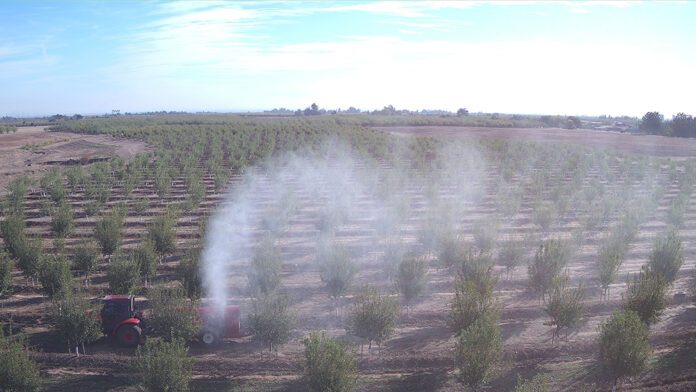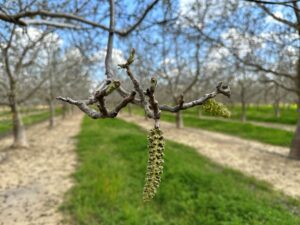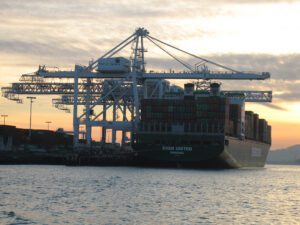
Each year, prior to the start of bloom, Mel Machado of Blue Diamond Almonds reminds growers of MRLs, or maximum residue levels, of pesticides allowed in foreign markets.
“We put out a letter saying, ‘So, here’s the situation,’” said Machado, Blue Diamond’s vice president of member relations.
The annual memo advising growers to avoid using certain compounds and stop using others at certain points of the growing season reflects a concern that reverberates throughout the tree nut industry as growers, processors and crop advisors plan ahead. Meeting the residue caps for foreign markets means everything in an industry that exports most of its product.
“When growers and PCAs are making decisions on how to manage an orchard, they’ve got to think about, ‘What’s the right thing to do for the crop and the pests that we are concerned about, what’s the right thing to do here in the state of California and what’s the right thing to do according to EPA,’” said Caroline Stringer, trade director for the California Fresh Fruit Association. “And then, ‘Oh, by the way, what is the right thing to do for any number of export markets that we have to contend with.’
“It is a complicated matter for any PCA or grower who is in charge of the integrated pest management for the orchard,” Stringer said.
At an industry organization level, monitoring MRL developments in foreign countries is also an ongoing and complicated matter. And, according to sources, European Union policies consistently cause the most concern.
“Europe has been the most common reason to express caution,” said Gabriele Ludwig, director of environmental affairs for the Almond Board of California.
As of press time, there were no changes pending for EU MRLs that were expected to be problematic, Ludwig said, either because compounds are not being used or no residues are being detected. However, the Almond Board and other tree nut organizations are expecting the pace of pesticides being reviewed in Europe to pick up over the next two to three years, with several compounds potentially not being renewed, a development that could directly affect MRL tolerances.
“There is a good chance that EU registration losses due to endocrine disruption concerns and other issues will mean more MRL changes,” Ludwig said. “While the EU says they are willing to consider import tolerances where needed, politically it is not clear how willing the EU member states will be to allow import tolerances if their growers can’t use the product.”
Another MRL issue that is percolating for tree nuts, Ludwig said, is Mexico has changed how it addresses MRLs. Whereas in the past, Mexico deferred to MRL tolerances established by the importing country, now importing countries need to get an affirmative action statement from Mexican officials that an MRL is acceptable.
“Registrants need to submit data packages for the MRLs to the Mexican authorities,” Ludwig said.

Pistachio MRLs
In pistachios, issues with MRLs can be exacerbated given with certain insecticides, pistachios tend to retain higher residue levels than other tree nuts, said Stephen Vasquez, executive director of the Administrative Committee for Pistachios.
“Part of the story is that we’re still trying to learn about the pistachio biology and why you could put the same amount of the same product at the same timing on almonds and on pistachios and come up with two different residue levels,” Vasquez said.
He noted the industry recently began funding research on the issue to potentially help growers and PCAs adjust application timing of their existing lineup of pesticides products and to help manufacturers better understand the needs of the pistachio industry when registering compounds.
“This is the first year, so we don’t have any numbers on that yet,” he said. “Sometime in January or February, we’ll have a better idea of what the first-year numbers look like.”
Also at issue for the pistachio industry is it lacks a pheromone for Gill’s mealybug, Vasquez said. Having a pheromone could expand pest control options into the use of mating disruption, he said, which could help lower insecticide use.
“The MRL issue began when pistachio growers switched to a multiple insecticide application approach for managing Gill’s mealybug as it increased and spread throughout the industry,” Vasquez said.
“If we had mating disruption, that would at least help improve or extend the efficacy of the lineup of products that we do have,” Vasquez said. “That is one of the things that is missing, and we do have some researchers who are looking into that.”

Walnut MRLs
In walnuts, the biggest MRL concern going into the fall involved working with the European Union on establishing a more workable tolerance for mancozeb than the current proposal of 0.01, according to Joshua Rahm, director of technical and regulatory affairs at the California Walnut Board and Commission.
“Getting an appropriate import tolerance established so that we can continue to have mancozeb available and in compliance with regulations is right at the top of the list of our priorities right now,” Rahm said.
The industry hopes to have the mancozeb issue resolved by next growing season to ensure there are no trade disruptions, Rahm said. In the meantime, the industry is advising growers to hold off on using mancozeb other than through chemigation.
“The recommendation is to make an initial application at the beginning of spring root flush, and then you can reapply it at 30-day intervals with a final application at fall root flush,” Rahm said. “And that is when it’s applied via chemigation through a pressurized irrigation system.”
The industry also is working to align the Korean and Japanese MRLs for Rhyme fungicide, or flutriafol, with the European MRLs for the compound, which are currently established at 0.02.
“We’re working towards having that resolved by 2027,” Rahm said. “These are lengthy, rigorous, sometimes tedious processes, but we definitely are working on having that product more widely available for our growers with limited use restrictions.”
Annual Exercise
California tree nut growers, PCAs and processors have largely been able to avoid significant issues with MRLs in foreign markets for several years running, according to sources. In many cases, because tree nuts are often pooled and growers don’t know where their nuts will end up, that has meant adjusting spray programs to accommodate the country with the most strident MRLs, an adjustment that can limit the tools available for growers.
“There are always issues with MRLs, but so far, they’ve not reared their head,” Machado said. “They are something that processors and marketers of ag products have to consider. We have to monitor the situation, and it’s an annual exercise to be aware of what’s new and what’s coming up so that you can avoid problems as you market that product and send it around the world.
“MRLs are just something you have to pay attention to, and so far, we’ve been able to work our way through it,” Machado said.















